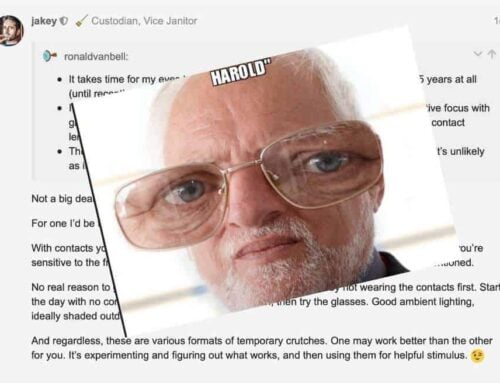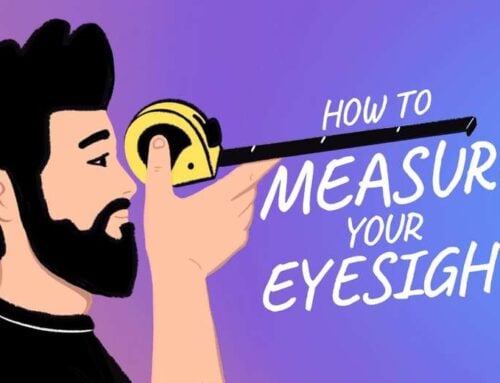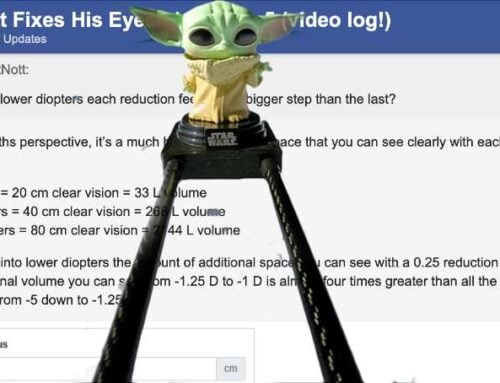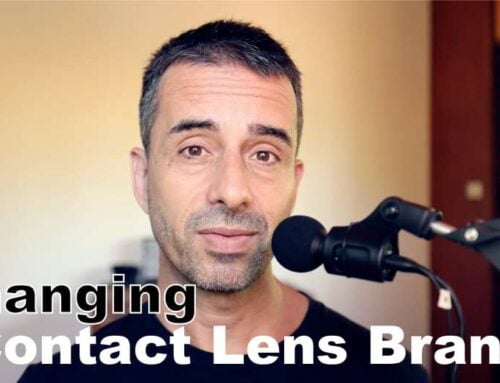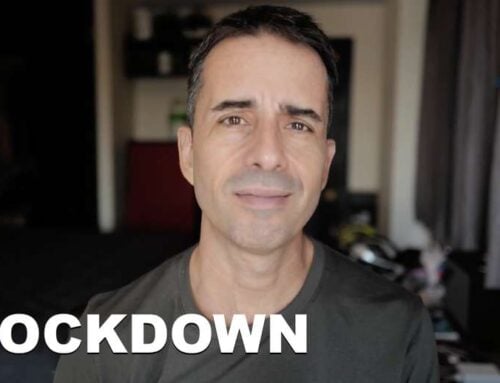Your optometrist is supposed to correct your vision deficiency. The goal should be for you to be able to see clearly at a distance. But how much correction are you actually given? And what does it do to you eyesight?
—
The optometry theory is that you should be able to see clearly at any distance. If your eyes work as they should, objects should just look smaller at greater distances, but never blurred. When you go to get an eye exam, the premise is to add however much prescription is possible, until you no longer notice a change with further increases.
That’s where the question of “is it clearer this way, or, this way” comes in. The optometrist continues to increase the diopters until you no longer notice additional clarity.
This is usually done in a darkened room with a brightly lit chart.
It’s very interesting how this works. The standing assumption is that you should just have this notion of perfect eyesight, no matter your age, your eye strain levels, and in the worst possible ambient lighting conditions. For some odd reason your eyes need to function at a level that none of the rest of your body is measured to.
Imagine you went for an annual physical, and it is determined that you are unable to run five miles in 35 minutes. Since that number is achievable by any superb athlete, it is assumed that your body should be able to do this as well. And since you are unable to do so, the doctor recommends that you either a) get a wheelchair to fix the apparent problem with your legs, or b) start taking HGH (human growth hormone) and other performance enhancers to improve your physical condition.
That sounds insane, doesn’t it?
And yet … your eyes, without any care being taken for their health, or any ongoing stimulus expected to keep them in peak condition, should let you see the 20/8 line on the eye chart?
Yes of course, some of us are genetically less predisposed to myopia. Some of us get a lot of outdoor time, don’t play computer games, don’t watch TV, are physically active and keep healthy diets. Those among us may indeed get away without being sold a prescription.
But that number is shrinking. And it would be shrinking much less if optometrists didn’t reach for the biggest possible gun anytime a mosquito buzzes past. Lens-induced myopia becomes a real problem, when you ratchet up that prescription to entirely excessive levels.
Take a look at this recent post by Kim from the forum:
![]() I just got my differential prescription glasses:
I just got my differential prescription glasses:
right eye
sphere: -6.25 cylinder: -0.50 axis: 170
left eye
sphere: -5.00 cylinder: -0.75 axis: 180
Current prescription:
right eye
sphere: -7.25 cylinder: -0.50 axis: 170
left eye
sphere: -6.00 cylinder: -0.75 axis: 180
With the differential prescription glasses, I did a test against a Snellen chart. Here were my results:
Right eye: 20/25 (slightly blurry)
Left eye: 20/30 (slightly blurry)
Both eyes: 20/25 (slightly blurry)
I can read the 20/20 line with both eyes but need to put in a bit more effort to make out the text (with some active focus).
—
The full thread, with some worthwhile reading, is here.
Do you see what is going on there? Kim has been sold a -7.25 / -6.00 prescription. Earlier in the thread she mentions that her optometrist refuses to reduce that prescription. But what happens when she goes a whole diopter lower?
She can still read 20/20.
That’s enough to pass the driver’s license exam requirement just about anywhere in the world. It’s perfectly acceptable vision, and basically natural eyesight for most of us.
But the optometry paradigm is that good enough isn’t good enough. They have to mess with things and really add as much prescription as possible. And then what happens?
Lens-induced myopia happens.
Look at that. 36,700 results on Google Scholar.
But ask the optometrist about what he knows about lens induced myopia, and you’ll probably get not much more than a shrug. Even though Kim’s -7.25 started as a -1.25 and went up every year or two, as a direct result of nothing more and nothing less than that prescription practice.
Yes, you get unnaturally amazing vision for a while. But after a year you are back to where you were, and you need more prescription to get back to that unnatural level. How does any of that make sense, any other way than relentless pushing of a product, no matter the health consequences?
I talk to a lot of bloggers who say that one should always just be positive and avoid any confrontational tones. This is a difficult task when you consider above. It’s probably difficult for Kim to accept, that trusting current optometry paradigms led to her significant myopia.
At least we can fix it. Even if it does take quite some time.
Take care of your eyes!
Cheers,
– Jake






